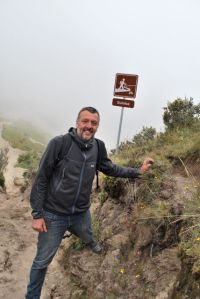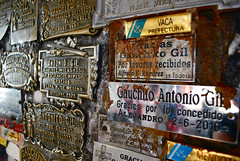Quito, Ecuador
[by Jeremy]
It’s often said to be an endearing quality in a man to be able to show emotion, to be able to shed a tear. It’s not quite so endearing when the man in question is on all fours, clinging to a rock and blubbing uncontrollably.
I am that man.
Before setting out on what was to turn out to be one of the best – and when I say best, I really mean both best and worst – treks of our entire trip, we asked our fellow overlanders Thomas and Sabine what the hike around the Quilotoa volcanic lake was like. “It’s fine they said, a little narrow in parts”.
I’m not sure what it was that possessed them to forget to mention the 1000ft sheer cliffs dropping straight in to the lake that, legend has it, is so deep it has no bottom. That’s the problem with people who don’t suffer from vertigo – no sense of impending doom!
Tears and tantrums aside, the hike from our base in Chugchilán to Quilotoa was stunning, the views incredible and the experience – well, an experience.
It all started so well – a steep hour-long hike down almost 1000m in to the depths of an amazing canyon. It was at this point we realised why most hikers did the trek in reverse. What goes down must go up – or something like that. In front of us was five hours of continuous up from the valley floor.
With burning knees, and gasping for breath at 3,500m, we reached our first summit – the village of Guayama. Incredible views down in to the canyon, to the volcanoes and mountains surrounding us in every direction and back to the precipitous path we had just climbed were a just reward.
At least that’s the worst part over we reassured ourselves. Oh yeah? From there we climbed gently to the foot of the final ascent. It’s one of those that doesn’t look too steep when you are gazing at it from a distance. Close up it looked monstrous. With the sun burning down, the air thinning and our limbs growing ever more weary we climbed and climbed to the lip of the volcano.
At least that’s the worst part over, we reassured ourselves. Oh yeah? As we reached the lip of the crater we were confronted with – depending on your level of vertigo – the most astonishing view of Quilotoa, an awe-inspiring sight or a terrifying path to certain death.
“The rational part of my brain appeared to have gone on its own trek somewhere far away.”
My natural reaction when confronted with such terror is to cling on to rock, often grazing my face and hands in the process as I physically try to climb inside the rock face – and to stop the spinning, I find getting on all fours helps. It’s not a great look.
Normally this lasts for a while before Paula can connect with the rational part of my brain and persuade me that I can do it. And I do.
Maybe it was the thinness of the air, or the tiredness, but the rational part of my brain appeared to have gone on its own trek somewhere far away from here. Seconds of frozen inaction became minutes and minutes became an hour. Despite my protestations there was no way we could head back the way we’d come before dark – or physically manage it – so, rationally, I decided we could just sleep out in the open, at 3800m, in the freezing cold and rain. Well, it seemed rational to me.
It was only the chance arrival of some other trekkers and a local guide who persuaded us we could make the last part. Frankly, the guide just lied to me about how the last part wasn’t so bad.
As we edged along the crater rim even I had to admit the views were out of this world. I even relaxed enough to enjoy them! An hour later we arrived at the village of Quilotoa, found a lovely hostel with a log fire in the room, ate, drank and were merry.
We awoke to a beautiful sunrise, and were greeted not only by stunning views of the emerald green lake far below but also by grazing llamas as we hiked down to sit at the lakeside – pure tranquility. After a few more wobbly-kneed moments climbing back up to the rim we rested our aching limbs enjoying a coffee in the town square while waiting for the bus back to Chugchilán. You didn’t think we were going to hike back did you?
At least that’s the worst part over, we reassured ourselves. Oh yeah?
The moment the bus set off in the midst of a swirling mountain storm and the local passengers began crossing themselves, we knew we were in for a bumpy ride. The dirt road began to turn in to a stream in parts, a quagmire in others. After a terrifying 15 minutes slipping and sliding along the side of the mountain we finally came unstuck. Less unstuck, perhaps, than stuck. As the bus slid backwards towards the edge of the cliff and the passengers screamed, we became firmly lodged in deep, deep mud. As everyone disembarked and diggers helped to get the bus moving again we joined a group of locals who, in sheeting mountain rain, walked past the next couple of nerve-jangling corners and rejoined the bus where the road looked less likely just to plunge in to the canyon.
It’s one thing when I’m irrational about falling over a cliff, but when Paula heads to the front of the bus and sits at the open door so she can jump off before we go over the edge, I know I’m being rational. An hour, several bitten fingernails and a couple of near-death experiences later, as we round a corner, the bus gets stuck again. This time it looks pretty final (as we find out a few hours later, when they finally get the bus out of its hole, this happens pretty much every day). Just a couple of kilometres short of our destination we decide to cut our losses and walk the final stretch.
Over a cold beer and warm dinner we relive our last 48 hours. And like all such tales, in our recounting the fear diminishes, our bravery grows until in the end the tears, the tantrums, the terror are just footnotes in an otherwise spectacular hiking experience. The scars are emotional – except for a couple of grazed hands – but the memories are among the best of the whole trip so far. It’s funny how these things work out.
Leaving Quilotoa we head back to Quito to pick up the van which has had its new fuel injector put in.
At least that’s the worst part over, we reassured ourselves. Oh yeah?
As we arrive at the mechanics, expecting to drive away, our van is being pushed in to the workshop. What!? Several days and a good deal of stress later we get the dreaded news that part of our rebuilt transmission is buggered.
The mechanics are baffled as to how an 11-month-old transmission could break. Our complaint to VW has been duly filed – we’ll let you know what compensation they decide to offer us….
As ever when big things go wrong with your vehicle on a road trip you start to think the worst, get upset, make all kinds of alternative plans and generally go in to a bit of a panic. We did all of the above. Before we knew it we were sat having afternoon tea with an elderly ‘colonial’ British couple, agreeing to look after their five dogs and sprawling finca on the outskirts of Quito for five months, and I had applied for a job as a football reporter in Ecuador.
In the cold light of day, the house-sitting plans didn’t work out – sadly we couldn’t co-ordinate our dates and the news on the transmission, bad though it was, was not as catastrophic as first feared. We could get the spare parts, sort it out and be back on the road almost within our planned schedule. So we have rented an apartment in Quito and set about enjoying life in a city we have come to really love – oh, and doing some freelance journalism to pay for the parts.
At least that’s the worst part over, we are reassuring ourselves.
The silver lining in all of this is that we realise our journey is not one straight line (and not just because we get lost a lot) or just one adventure but a whole series of different adventures and experiences and if we have to stop for a while, have to get local jobs, have to change our plans we are ready, willing and able to do it.
After we’ve had a little panic, obviously.
Days: 558
Miles: 17,551
Things we now know to be true: “To want to tackle everything rationally is irrational.” [Ilyas Kassam – writer]


































Excellent post, I enjoyed every bit of it. Even though we are setting of in 3 months, we already had our share of “alternative plans” and “panic situations”. But we still can’t wait to set off.
Thanks Marek. Good luck with your plans!
Shame! I really wanted to see a photo of the ‘big boy’ blubbing!
Oherwise, very interesting.
Aye Dad – says the man who shared a glassy eye with me the other day when I was telling proud stories of the grandchildren 🙂
Great blog Jeremy – and you’re right – rationality is over rated. Altitude makes you feel weird at the best of times never mind with vertigo – great to hear that as usual you don’t let it stop you (for too long anyway) 🙂
We are really enjoying reading your posts! The photos are beautiful and you are both wonderful writers. Hoping to see you in Ecuador and best of luck with the van!!
We are really enjoying reading your posts. The photos are gorgeous and you are both wonderful writers. We hope to see you in Ecuador and wish you the best of luck with the van!